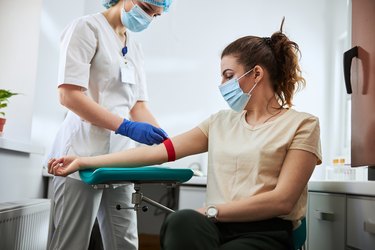
White blood cells are measured with a blood test called the complete blood count, or CBC, as part of a routine physical or when your doctor suspects you have an illness or infection. There's not much you can do to increase white blood cells, but you can protect your immune system by taking certain steps.
White blood cells, or WBC, also called leukocytes, are made in the bone marrow and found in the blood and lymph tissue, according to the National Cancer Institute. As part of your immune system, they help your body fight infection and other diseases. There are five major types of white blood cells:
Video of the Day
Video of the Day
- Basophils
- Eosinophils
- Lymphocytes
- Monocytes
- Neutrophils
An important marker for doctors to monitor your health, your white blood cell count may be taken to look for conditions such as infection, inflammation, allergies or leukemia.
Normal White Blood Cell Levels
White blood cells range in number from 4,500 to 11,000 per microliter of blood, according to the U.S. National Library of Medicine (NLM). If that number falls below 4,500, it's called leukopenia.
Getting to the root of the issue can help. There are many reasons why your white blood cell count may be lower than normal, says Alan Lichtin, MD, a hematologist at the Cleveland Clinic:
- In addition to serious blood and lymph diseases such as lymphoma and leukemia, a low WBC count can be a sign of inflammatory disorders such as lupus, or disorders of the liver or spleen like cirrhosis of the liver.
- Cancer in the bone marrow can impair production of white blood cells, while chemotherapy drugs can temporarily lower the white blood cell count.
- Many other drugs can lower your white blood cell count, including some anti-seizure medications.
People with low WBC may tend to feel fatigued, but "lots of people walk around with low WBC count and show no symptoms," Dr. Lichtin says.
Read more: Why White Blood Cell Count Drops With Exercise
What to Do if Your White Blood Cell Count Is Low
Because having a low white blood cell count weakens your immunity to foreign invaders, it's important to take steps to avoid infections, according to the NLM:
- Take care when handling pets and other animals.
- Wash your hands often with soap and water.
- Limit your exposure to crowds and people who show symptoms of an infection.
People with an abnormally low number of neutrophils, the white blood cells that sense infections and destroy pathogens, have a condition called neutropenia. When the neutrophil count falls below 1,000 per microliter of blood, it becomes harder for the body to fight off infections. Patients with neutropenia often complain of symptoms that include fever, shaking and chills, Dr. Lichtin says.
Watching what you eat and drink is also important for people with neutropenia. Dr. Lichtin recommends following a neutropenic diet, which minimizes your exposure to pathogens in food. While a neutropenic diet won't boost your white blood cell count, it can lower the risk of infection.
Memorial Sloan Kettering Cancer Center offers these guidelines for following a neutropenic diet:
- Thoroughly rinse fresh fruit and vegetables under warm running water and scrub or brush produce to remove dirt.
- Use separate cutting boards for meat and produce, and avoid wooden chopping boards.
- Refrigerate or freeze food immediately after purchase.
- Defrost food in a refrigerator, in cold water or by microwave, not on the counter or in the kitchen sink.
Avoid these foods in particular:
- Raw and undercooked meat, fish, eggs and shellfish
- Salad bars, buffets and potlucks
- Foods that are past their expiration dates
- Leftovers older than 48 hours
Dr. Lichtin also advises some patients to limit or avoid alcohol, because alcohol can suppress white blood cells by interfering with blood cell production in the bone marrow.
Read more: 11 Food-Safety Mistakes You Don't Know You're Making
Was this article helpful?
150 Characters Max
0/150
Thank you for sharing!
Thank you for your feedback!
Is this an emergency? If you are experiencing serious medical symptoms, please see the National Library of Medicine’s list of signs you need emergency medical attention or call 911.